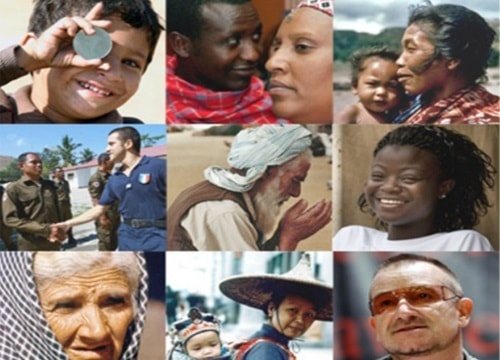Extracurricular event “Tolerance is the path to peace”
Extracurricular activity
“Tolerance is the path to peace”
(4th grade)
Topic: Tolerance is the path to peace.
Purpose: to define tolerance;
determine the qualities of a tolerant person;
continue to familiarize children with the concept of “tolerant attitude”;
continue to develop a tolerant, merciful, tolerant attitude towards peers and adults;
continue to develop the desire to provide help and be ready to accept it;
develop intolerance towards any type of violence.
Equipment: cards with inscriptions (names, conceptual apparatus), cards with provisions from world religions (for work in pairs), envelopes for work in groups (each envelope contains a list with various human qualities), “magic chair” and “magic wand” ”, musical accompaniment (children’s songs about friendship - “A smile will make everyone brighter”, “It’s fun to walk together”, “Sunny circle”).
Progress of the lesson
Teacher
The world is the Universe. The world is our Earth. The world is our country. The world is our city. The world is our school. The world is me. How diverse the world around us is. We are all so different: adults and children, blondes and brunettes, kind and evil, plump and thin, bald and with pigtails, smart and not very smart. And we all must live and understand each other. There is such a beautiful word “tolerance” (the word appears on the board). How do you understand it?
Teacher
Tolerance is quite difficult to describe, perhaps because it is defined differently in different languages (definition cards are pinned to the board).
In English, tolerance is “the willingness and ability to accept a person without protest.”
In French, tolerance is “respect for the freedom of another, his way of thinking.”
In Arabic, tolerance is “forgiveness, forbearance, compassion, patience.”
In Persian, tolerance is “readiness for reconciliation.”
The Russian dictionary interprets tolerance as tolerance - the ability to tolerate something or someone, to tolerate a different way of life, different behavior, feelings, opinions, ideas. To be self-possessed, to be able to put up with the existence of someone, to take into account the opinions of others, to be lenient.
Teacher
Now we will work in pairs . Each couple has provisions on the table taken from world religions. Think about what each religion says:
- “Don’t do to someone else what hurts you.”
- “In everything that you want people to do to you, do so to them.”
- “Consider your neighbor’s success your success and your neighbor’s loss your loss.”
- “In happiness and suffering, in joy and sorrow, we must treat all beings as we treat ourselves.”
Teacher
Express these thoughts in your own words.
What is the general meaning of these statements?
Of course, guys, everything is true: “People should be lenient with each other, more tolerant, respect the opinions of others. They must be tolerant of each other."
But tolerance must have a face! Tolerance must have some qualities of its own. What qualities do you think tolerance should have?
Let's try to characterize a person who has a tolerant attitude (work in groups).
So let's try it. You have an envelope on the tables for each group with different qualities of a person. Try to choose five qualities that, in your opinion, correspond to a tolerant person (the class is divided into groups into rows, an envelope is placed on the first desk of each row-group).
Envelope 1: condescension, gloating, lies, conflict, kindness, respect, understanding, peacefulness, heartlessness, compassion, generosity, tactlessness, forgiveness, rudeness, warmth.
Envelope 2: kindness, warmth, tolerance, boasting, equality, rudeness, mercy, arrogance, compassion, cooperation, respect, generosity, understanding, anger.
Envelope 3: peacefulness, heartlessness, forgiveness, equality, respect, mercy, tolerance, temper, dialogue, irritation, cordiality, conflict, compassion, generosity.
Teacher
Guys! Let's check what we have done (a representative of each group reads out the answer of his group, then cards with the qualities that are most often encountered are attached to the board).
Thus, guys, we have grown an associative bush for the concept of “tolerance”.
| kindness | peacefulness | compassion | tolerance | generosity |
| cordiality | tolerance | understanding | ||
| respect | ||||
| forgiveness | mercy |
Think about it, do we all have these qualities? Can we all calmly listen to each other? To support people in difficult times, to understand people who are different from us, to resolve conflicts peacefully?
Can we change ourselves? Can we cultivate in ourselves the qualities we are talking about today? How can we do this?
Teacher
To do this, you and I will play the game “Let’s give each other compliments.”
Let us prove to each other that we are kind, understanding, tolerant people.
Each of us is pleased when he is praised, good, kind words are said about him, especially when it is deserved.
Any person wants to be loved and respected, appreciated and understood, and very often we simply need to hear kind words and wishes from the people around us. After all, this improves our mood and we are ready to share our joy and help others.
Now each of you who sits on the “magic chair” and picks up a magic wand will learn a lot of good things about yourself, and all the other guys will tell you about the positive qualities of this person.
For example: thank you for being such a kind and considerate friend; I like the way you laugh and joke; you are great at helping others.
Teacher
After all the children have been on the “magic chair,” the teacher discusses with the class what the children felt during the exercise:
- Did you like this yoke?
- Why?
- What new things have you learned about each other?
- Were the compliments the same or different?
- Why different?
Indeed, guys, every person is unique, every person is an individual, a person with his own characteristics. If we were all the same, life in the world would simply not be interesting.
Teacher
And finally, listen to these lines of A. Usachev’s poem “The Amazing Dwarf”.
There was an amazing house by the river. An amazing gnome lived in that house. His beard grew to the floor, and in that beard lived a Star.
This dwarf knew neither worries nor worries. The star illuminated the whole house and lit the stove, and cooked porridge, and told him fairy tales before bed...
And the dwarf scratched his beard with admiration, Which was, of course, pleasing to the Star. She fed only on crumbs of bread, and at night she flew to the sky for a walk.
So the years and centuries went by slowly... But one day the flour in the house ran out. And the gnome, having said goodbye to the hatched stove, went to the city across the river at dawn.
And in that city they didn’t wear beards.
- Ha-ha, Ho-ho-ho! - the people began to laugh - What a scarecrow! - everyone told him. And the dwarf got scared.
And he shaved his beard.
And his beard fell to the floor, And then his star set. There is now an ordinary house near the river. An ordinary gnome lives in this house.
His beard grew again, but the Star never returned to him.
Yes, guys, you always need to remember, we are all very different, each has its own characteristics, not to mention the inner world of each person. We must respect the individuality of each person, because we are all people, we have differences, but each of us is not the same and is needed by everyone else.
Unfortunately, people are not always tolerant of each other, but I hope that the time will come when all people will treat each other with respect, and no one will offend anyone. Each person will have his own beliefs, will defend his point of view, and all people will learn to negotiate, and will not fight, swear, or conflict.
Let your star always live with you, amazing, unique, independent and friendly.
Homework.
Creative work – Image of tolerance.
Teacher
We have already given the characteristics of a person who has a tolerant attitude. Now let's try to create an image of tolerance (the kids need to draw an image, make an applique, make a composition from plasticine, use photographs, soft toys or any other materials).
And remember that on earth small and big, fat and thin, white and black, cats and dogs, adults and children, Africa and Eurasia should be friends... they should be able to negotiate with each other.
And at the next class hour we will see what images you have created. Each of you will be able to defend your image of tolerance.
Applications
Cards with definitions of the concept of “tolerance”:
In English, tolerance is “the willingness and ability to accept a person without protest.”
In French, tolerance is “respect for the freedom of another, his way of thinking.”
In Arabic, tolerance is “forgiveness, forbearance, compassion, patience.”
In Persian, tolerance is “readiness for reconciliation.”
The Russian dictionary interprets tolerance as tolerance - the ability to tolerate something or someone, to tolerate a different way of life, different behavior, feelings, opinions, ideas.
Cards with statements from world religions
(for working in pairs):
- Don’t do to others what hurts you.”
- “In everything that you want people to do to you, do so to them.”
- “Consider your neighbor’s success your success and your neighbor’s loss your loss.”
- “In happiness and suffering, in joy and sorrow, we must treat all beings as we treat ourselves.”
Envelopes for working in groups (each envelope contains a list with various human qualities):
Envelope 1: condescension, gloating, lies, conflict, kindness, respect, understanding, peacefulness, heartlessness, compassion, generosity, tactlessness.
Envelope 2: kindness, warmth, boasting, equality, rudeness, mercy, arrogance, compassion, cooperation, respect, generosity.
Envelope 3: peacefulness, heartlessness, forgiveness, equality, respect, mercy, temper, dialogue, irritation, cordiality, conflict, generosity.
Cards with inscriptions of the qualities of a tolerant person
(for associative bush):
tolerance , forbearance, kindness, respect, understanding, peacefulness, compassion, generosity, cordiality, equality, mercy, cooperation, tolerance, forgiveness, dialogue.
Literature:
1. Brief philosophical encyclopedia M., Progress. Encyclopedia, 1994
2. Vulfov B.Z. “Education of tolerance, essence and means” Out-of-school student-2002 No. 6.
3. Declaration of principles of tolerance. Approved by resolution 5.61 of the General Conference of UNESCO on November 16, 1995.
4. Rozhkov M.I., Bayborodova Ya.V., Education of tolerance among schoolchildren. Yaroslavl 2005
Who celebrates the holiday?
The beauty of our world lies in its diversity. It is thanks to the diversity of views, religions, and thoughts of people that the development of civilization occurs in many ways. That’s why respect for someone else’s point of view and identity is so important. Discrimination leads to extremism, violence and even wars on this basis.
Everyone who understands the importance of tolerance, the meaning of tolerance, will celebrate Tolerance Day in 2022 in Russia. And these will not just be empty words about the importance of understanding and respect, but actions that will bring people closer together and avoid violence.
history of the holiday
“Tolerance means respect, acceptance and proper understanding of the rich diversity of our world’s cultures, forms of self-expression and manifestation of human individuality.” Article 1 of the UNESCO Declaration of Principles on Tolerance. It is with this document that the history of the International Day of Tolerance begins, which has become a symbol of tolerance throughout the world. The proclamation of the principles and the holiday itself took place in 1995. Both events are associated with the 50th anniversary of the organization.

In 1997, the UN Assembly calls on participating countries to join in the celebration and declares the Year of Tolerance. Intolerance is seen as a threat to humanity. Therefore, within the framework of the holiday and declaration, programs to combat intolerance, discrimination, and extremism are being developed.





